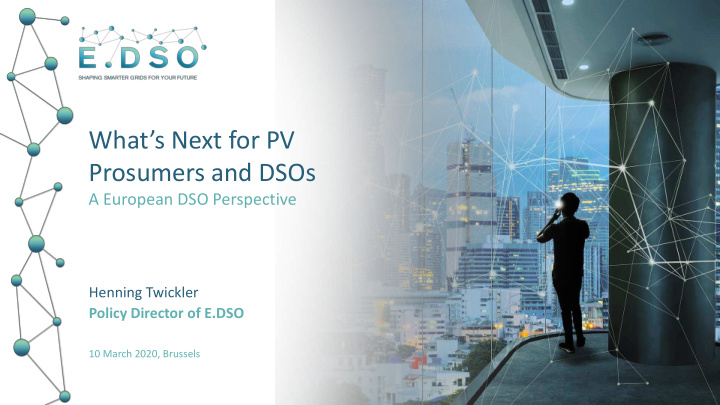



What’s Next for PV Prosumers and DSOs A European DSO Perspective Henning Twickler Policy Director of E.DSO 10 March 2020, Brussels
E.DSO members 41 Distribution System Operators, including 2 Associations >350 million Customers 7 million kilometres of distribution lines
E.DSO in figures and map Founded in 2010 10 full-time staff in E.DSO Secretariat Participation in 12 EU-funded research projects Participation in all EU expert groups in Smart Grids (SGTF, ETIP SNET, TSO/DSO Platform)
Relevant provisions in the Clean Energy Package • Art.2(8) Electricity Dir.: ‘ ‘active customer’ means a final customer, or a group of jointly acting final customers, who consumes or stores electricity generated within its premises located within confined boundaries or, where permitted by a Member State, within other premises, or who sells self-generated electricity or participates in flexibility or energy efficiency schemes, provided that those activities do not constitute its primary commercial or professional activity ;’ • Art.15 Electricity Dir. further specifies the rights and obligations of active customers: • can operate directly or through aggregation • can delegate to 3 rd party the management of their installations (incl. installation, operation, data handling and maintenance) • Subject to cost-reflective, transparent and non-discriminatory network charges, accounting separately for electricity consumption and feed-in; adequate and balanced contribution to system costs • Balance responsible • Art. 16.2(d ) Electricity Dir.: ‘ with regard to consumption of self-generated electricity, citizen energy communities are treated like active customers’
Two types of scenarios Type 1: RES Generation Units Type 2: Self- consumption Generation Units
Type 1: RES Generation Units • Example: North-East of the Netherlands • 27 of 65 solar parks in Groningen and Drenthe (2018) • Total of 71 solar parks already approved in the two provinces (1,235 MW) • Projects primarily developed in regions that are sparsely populated, with lower land prices • However, also the network is generally less developed; congestion issues • Planning and construction took 3 years on average in the past, now it is 5+ years • Some considerations: • Ramp up network investments • Involve local communities • Involve DSOs early on in the planning process • Stimulate self-consumption • Congestion management through flexibility • Storage solutions, power-to-gas Source: DvhN, 7 March 2020
Type 2: Self-consumption Generation Units • Some considerations: • Locally produced energy consumed locally ☺ • However, keep in mind that capacity is the driving factor of grid costs, not volume • Importance of smart meters → needed for active customer participation and increased grid visibility • Regulation should promote clean and local generation and efficient grid development, incl. reinforcements and digital solutions • Legislative developments for 2020: • Demand side flexibility network code • European Green Deal (citizen mainstreaming in revision of relevant energy legislation, incl. smart sector integration strategy, TEN- E…) • E.DSO endorses 11 th Citizens’ Energy Forum conclusions: “[ c]onsumers should be encouraged to switch to sustainable energy use, while ensuring that no consumers are left behind irrespective of the source of energy they use”
Thank you for your attention!
Recommend
More recommend